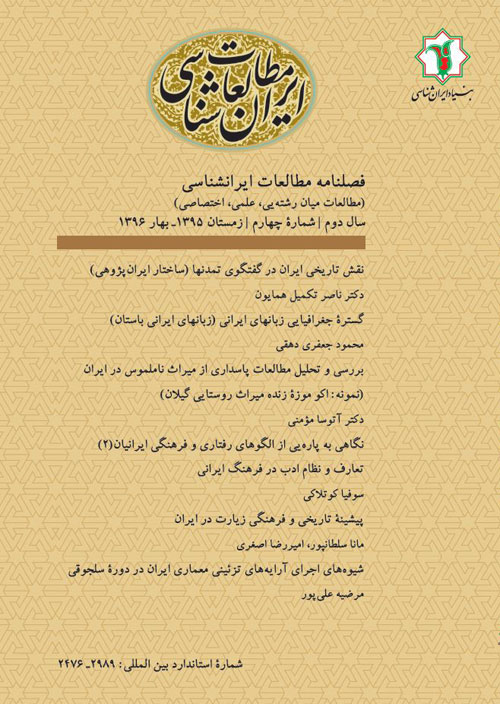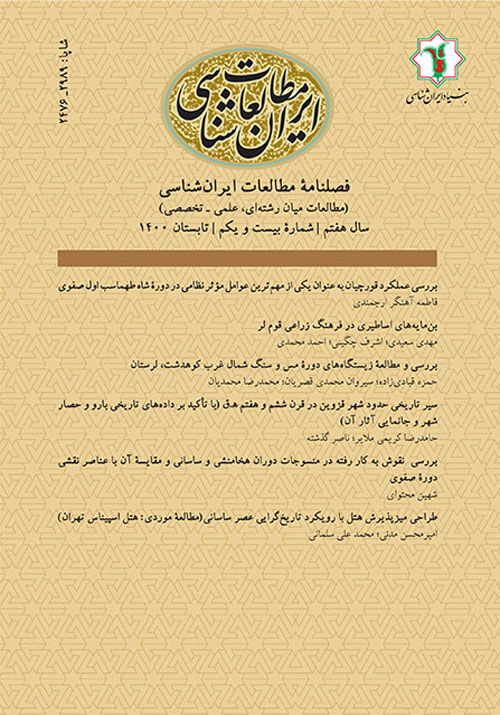فهرست مطالب

نشریه مطالعات ایرانشناسی
پیاپی 4 (زمستان 1395)
- تاریخ انتشار: 1395/12/01
- تعداد عناوین: 7
-
صفحات 5-7
-
صفحات 8-19این مقاله به مسئله گفتگوی تمدن ها که در عصر حاضر از اهمیت و جایگاه ویژه یی برخوردار است، می پردازد. نویسنده با روش توصیفی و کتابخانه یی و نیز بر اساس تجارب شخصی، ضمن ارائه پیشینه تمدنی و جغرافیای تمدنی از ایران، به تقابل و تعامل ایران با تمدن های باستان(شرق و غرب) و تمدن اسلام پرداخته است. وی معتقد است با شناخت فرهنگ و تمدن ایران که از راه بررسی تحولات تاریخی و باستان شناسی محیط زیست و جغرافیای جامعه و ارزش های موجود در آن قابل حصول است، میتوان ایران را بعنوان یکی از پیشگامان گفتگوی فرهنگی و تاریخی در تاریخ معرفی کرد.کلیدواژگان: گفتگوی تمدن ها، نقش ایران، هویت ملی، تمدن های باستانی، پیشینه تمدنی، پیشینه باستان شناسی
-
صفحات 20-30زبان های ایرانی را از دیرباز به سه گروه ایرانی باستان، ایرانی میانه و ایرانی نو طبقه بندی کرده اند. این تقسیم بندی صرفا بدلیل سهولت تجزیه و تحلیل زبان های مذکور است. زبانهای ایرانی باستان مربوط به دوره مادها و هخامنشیان و زبان های ایرانی منسوب به عصر اشکانیان و ساسانیان است. زبان های ایرانی نو را متعلق به دوره اسلامی تا امروز می دانند. نوشتار حاضر با روش توصیفی، نگاهی کوتاه به زبان های ایرانی و شاخه های آن، آنها را مهمترین عامل همبستگی میان اقوام ایرانی میداند.کلیدواژگان: زبان، بستگی، اتحاد، ایرانی، باستان، میانه، نو
-
صفحات 31-64این مقاله با مروری بر سیر تحول دانش مردم شناسی در ایران به مطالعات فرهنگ عامه و روند تغییرات رویکردی در شناسایی، آگاهی افزایی، ارتقا و انتقال بین نسلی میراث فرهنگی ناملموس پرداخته است. میراث فرهنگی ناملموس- که یکی از بهترین داشته های ارزشمند فرهنگی ملت ها در جهان شناخته می شود- می تواند بنا به ظرفیت سیال و مرزنوردش، جوامع را بسوی همگرایی و وفاق سوق داده و ارمغان آور صلح پایدار جهانی باشد. بنابرین شناخت صحیح، معرفی و آگاهی افزایی درباره آن، ضامنی در حفاظت و مدیریت انتقال بین نسلی خواهد بود. توجه به این وجه از میراث بشری در جهان بسیار نوپاست و بعد علمی و سیستماتیک آن به بعد از کنوانسیون 2003 .م یونسکو باز میگردد؛ اما در سالهای اخیر مطالعات در مورد آن بطور فزاینده یی درمیان ملتها با اقبال ویژه یی مواجه شده است. نویسنده در این مقاله درصدد است تا با بررسی روند مطالعات مردم شناسی (با هدف صیانت و تغییر عنوان در ادبیات فرهنگی و تاریخی)، ضمن اشاره به مطالعات میراث فرهنگی ناملموس کشور، ظرفیت ها و چالش های پی شرو را در عرصه پژوهش های مربوط به حفاظت از آن معرفی کرده و راهکارهایی جدی و اجرایی برای آن پیشنهاد دهد. وی همچنین تلاش میکند تا بر اساس نمونه های موفق و تجربیات و آزموده های پرثمر ملی و بین المللی، صور فرهنگ بشری و جلوه های میراث ناملموس آن را منطبق با استانداردهای خلاقانه تعیین شده از سوی سند کنوانسیون جهانی 2003 .م یونسکو نشان داده و مشارکت برپادارندگان و حاملان و ناقلان این وجه از میراث زنده بشری را بطور فزاینده یی جلب کند. در پایان این پژوهش به اکوموزه گیلان، بعنوان نمونه یی از برترین اقدامات پاسدارانه از میراث ناملموس فرهنگی توجه شده است.کلیدواژگان: مطالعات پاسداری از میراث فرهنگی ناملموس، کنوانسیون 2003، م، ضعفها، قوتها، راهکارها
-
صفحات 65-88این مقاله به تعارف و نظام ادب در رفتار و تعاملات ایرانیان اشاره کرده است. نویسنده معتقد است، رعایت ادب کلامی، فردی و اجتماعی، تعارف و گفتگوهای روزمره، شامل احوالپرسی، دعوت، درخواست و غیره از نظام مشخصی تبعیت می کنند. وی با انجام پژوهش میدانی و ضبط داده ها و تحلیل و مقایسه آنها نتیجه گرفته است که این مناسبات همگی در زیرمجموعه اصل فراگیر آداب و تعارف از سه ریشه احترام، تواضع و صمیمیت ایرانی ناشی میشود.کلیدواژگان: رفتار ایرانیان، نظام ادب، تعارف، احترام، تواضع، صمیمیت، رفتارپژوهی فرهنگ درونی، رفتارپژوهی فرهنگ بیرونی
-
صفحات 89-108زیارت مکان های مقدس و منسوب به بزرگان و نیکان یکی از سنت های فرهنگی ایرانیان است که از دیرباز اهمیت و اعتبار خود را حفظ کرده است. این اماکن در سراسر سرزمین ایران با تنوع موقعیت قومی، جغرافیایی ومذهبی پراکنده اند و کمتر شهر و روستایی را میتوان یافت که سهمی از این بناها نداشته باشد. با عنایت به تنوع و گونه گونی اماکن مقدس در مجموع می توان این اماکن را به قبور سادات، علما، مشایخ و قدمگاه و یا نظر کرده تقسیم بندی نمود. نوشتار حاضر با تکیه بر پژوهش میدانی و بررسی منابع کتابخانه یی، مقدمه یی است تاریخی، بر تطور زیارت مکان های مذکور در ایران و تاثیری که از حاصل آن در فرهنگ مردم این کشور ایجاد شده است.کلیدواژگان: زیارت، اماکن مقدس پیش از اسلام، علویان، سادات، علما، مشایخ
-
صفحات 109-135در دوره سلجوقیان هنر و معماری ایران از رشد و تحول چشمگیری برخوردار شده بود. این دوره را میتوان سرآغاز استفاده از کاشی های رنگارنگ در معماری و زمینه یی برای رونق و پیشرفت تزئینات در دوره های بعدی خواند. همچنین آجرکاری، گچبری و رنگ آمیزی در معماری و نیز ایجاد نقوش متفاوت در پوشش بناها از جمله هنرهایی بودند که در معماری عصر سلجوقی کاربرد گسترد هیی یافتند. از این رو، گرایش به تجمل گرایی درآثار این دوره عامل مهمی در پیدایش رنسانس هنری محسوب میشود. این مقاله با اتخاذ روش توصیفی ضمن معرفی معماری دوره سلجوقی، به بررسی ویژگی ها و اسلوب معماری اسلامی قرون پنجم و ششم ه.ق، در قلمرو هنر و معماری ایرانی میپردازد.کلیدواژگان: معماری ایرانی، دوره سلجوقی، عناصر تزئینی، آجرکاری، گچبری، کاشیکاری
-
Pages 5-7
-
Pages 8-19This paper deals with the problem of the dialog of civilizations, which enjoys particular importance in the present period. Following a descriptive-library method and drawing on personal experience, while introducing the civilizational history and geography of Iran, the writer focuses on the interactions and conflicts between the Iranian civilization and ancient (both eastern and western) and Islamic civilizations. He maintains that, in the light of the knowledge of Iranian culture and civilization, which could be gained through a study of the historical and archeological changes in the environment, social geography, and social values of Iran, one can introduce this country as one of the pioneers of cultural and historical dialogs in the history of the world.Keywords: dialog of civilizations, role of Iran, national identity, ancient civilizations, civilizational background, archeological background
-
Pages 20-30Iranian languages have been classified into three ancient, middle, and new groups since long ago. This classification simply serves to facilitate the analysis of the related languages. Ancient Iranian languages are related to the Medes and Achaemenid periods, and middle Iranian languages are attributed to Parthian and Sassanid eras. New Iranian languages appeared in the Islamic period and have been spoken until the present time. Following a descriptive method, while casting a glance at Iranian languages and their branches, the present paper considers them to be the most important factor unifying different Iranian ethnic groups.Keywords: language, unity, Iranian, ancient, middle, new
-
Pages 31-64This paper deals with studies of popular culture and the process of the changes in approaches to the identification, knowledge enhancement, promotion, and innergeneration transfer of the intangible cultural heritage based on a review of the process of the development of the science of anthropology in Iran. The intangible cultural heritage, which is considered to be one of the precious cultural assets of world nations, , due to its flowing and border-free potential, can lead different societies towards agreement and convergence and herald sustained world peace. Hence, a correct knowledge of this heritage, introducing it to all nations, and increasing people’s understanding of this valuable asset could be a strong guarantee for safe-guarding it and transferring it from one generation to the next one. The study of this aspect of human heritage in the world is still in its infancy, and its scientific and systematic treatment started just after UNESCO’s 2003 Convention. However, it has attracted the attention of an increasing number of researchers in recent years. In this paper, through an investigation of anthropological studies in Iran (with the purpose of safeguarding it and changing its title in the cultural and historical literature) and while referring to the studies on the intangible cultural heritage in this country, the author aims to introduce the potentials and existing challenges in the domain of research on protecting this heritage and provide some practical solutions in this regard. She also tries to demonstrate that the forms of human culture and manifestations of its intangible heritage conform to the established creative standards of UNESCO’s “Convention for the Safeguarding of the Intangible Cultural Heritage” (2003) through referring to a number of successful and beneficial national and international examples and experiments in this field. In this way, she hopes to attract the increasing attention and cooperation of the different organizations and parties interested in this aspect of the living human heritage. At the end of this paper, the writer refers to the Eco-Museum of Gilan as an example of the most efficient endeavors at protecting the intangible cultural heritage in the Iran.Keywords: studies on safeguarding the intangible cultural heritage, UNESCO’s 2003 Convention, weaknesses, strengths, strategies
-
Pages 65-88This paper deals with complements and the system of politeness in Iranians’ conduct and interactions. The writer believes that observing the norms of linguistic, individual, and social politeness; complements, and everyday conversations, including greetings, invitations, requests, etc., follows a specific system. Based on field studies and the analysis and comparison of recorded data, the author concludes that all such relations and interactions in Iran are rooted in respect, modesty, and sincerity of Iranians.Keywords: Iranians’ conduct, system of politeness, complement, respect, modesty, sincerity, behavioral study of internal culture, behavioral study of external culture
-
Pages 89-108Visiting sacred places attributed to great men is one of the original cultural traditions of Iranians, which has maintained its importance and value since ancient times. These places are scattered all over Iran enjoying a wide variety of ethnic, geographical, and religious features. In fact, there are rarely any cities, towns, or villages where there are no sacred places for pilgrims. Given the diversity of holy places, they can be generally divided into different groups: graves of the Prophet’s descendants, religious scholars, or Sheikhs; footholds, and blessed sites. Relying on field studies and library resources, the present paper provides a historical account of the development of the tradition of visiting the above places as pilgrims in Iran and the effects of pilgrimage on Iranian culture.Keywords: pilgrimage, pre-Islamic sacred places, the Alawites, descendants of the Prophet(s), religious scholars, sheikhs
-
Pages 109-135During the Seljuk era, Iranian art and architecture experienced significant growth and change. This period can be said to mark the beginning of the use of colorful tiles in architecture and paving the way for the flourishing and progress of decorative arts in later periods. Some of the arts which were widely employed in the architecture of the Seljuk era included brick work, stucco decoration, coloring, and creating various designs in the exterior sides of buildings. Accordingly, the love of luxury, as manifested in the architectural works of this period, is considered to be an important factor in the development of artistic renaissance. Following a descriptive method, while introducing the architecture of the Seljuk period, this paper examines the features and methods of Islamic architecture of the fifth and sixth centuries (AH) in the realm of Iranian art and architecture.Keywords: Iranian architecture, Seljuk Period, decorative elements, brick work, stucco artwork, tiling


